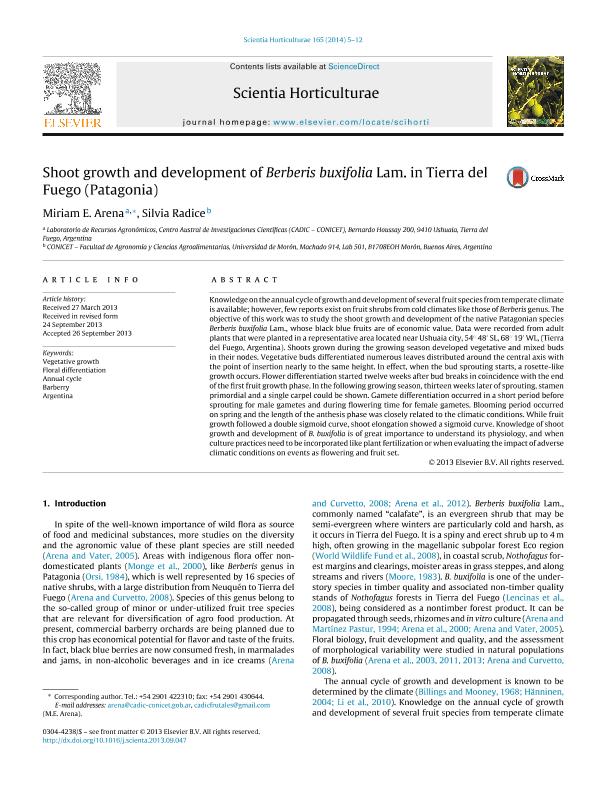Artículo
Shoot growth and development of Berberis buxifolia Lam. in Tierra del Fuego (Patagonia)
Fecha de publicación:
10/2014
Editorial:
Elsevier Science
Revista:
Scientia Horticulturae
ISSN:
0304-4238
Idioma:
Inglés
Tipo de recurso:
Artículo publicado
Clasificación temática:
Resumen
Knowledge on the annual cycle of growth and development of several fruit species from temperate climate is available; however, few reports exist on fruit shrubs from cold climates like those of Berberis genus. The objective of this work was to study the shoot growth and development of the native Patagonian species Berberis buxifolia Lam., whose black blue fruits are of economic value. Data were recorded from adult plants that were planted in a representative area located near Ushuaia city, 54° 48′ SL, 68° 19′ WL, (Tierra del Fuego, Argentina). Shoots grown during the growing season developed vegetative and mixed buds in their nodes. Vegetative buds differentiated numerous leaves distributed around the central axis with the point of insertion nearly to the same height. In effect, when the bud sprouting starts, a rosette-like growth occurs. Flower differentiation started twelve weeks after bud breaks in coincidence with the end of the first fruit growth phase. In the following growing season, thirteen weeks later of sprouting, stamen primordial and a single carpel could be shown. Gamete differentiation occurred in a short period before sprouting for male gametes and during flowering time for female gametes. Blooming period occurred on spring and the length of the anthesis phase was closely related to the climatic conditions. While fruit growth followed a double sigmoid curve, shoot elongation showed a sigmoid curve. Knowledge of shoot growth and development of B. buxifolia is of great importance to understand its physiology, and when culture practices need to be incorporated like plant fertilization or when evaluating the impact of adverse climatic conditions on events as flowering and fruit set.
Palabras clave:
Vegetative Growth
,
Floral Differentation
,
Annual Cycle
,
Barberry
,
Argentina
Archivos asociados
Licencia
Identificadores
Colecciones
Articulos(CADIC)
Articulos de CENTRO AUSTRAL DE INVESTIGACIONES CIENTIFICAS
Articulos de CENTRO AUSTRAL DE INVESTIGACIONES CIENTIFICAS
Articulos(SEDE CENTRAL)
Articulos de SEDE CENTRAL
Articulos de SEDE CENTRAL
Citación
Arena, Miriam Elisabet; Radice, Silvia; Shoot growth and development of Berberis buxifolia Lam. in Tierra del Fuego (Patagonia); Elsevier Science; Scientia Horticulturae; 165; 10-2014; 5-12
Compartir
Altmétricas




